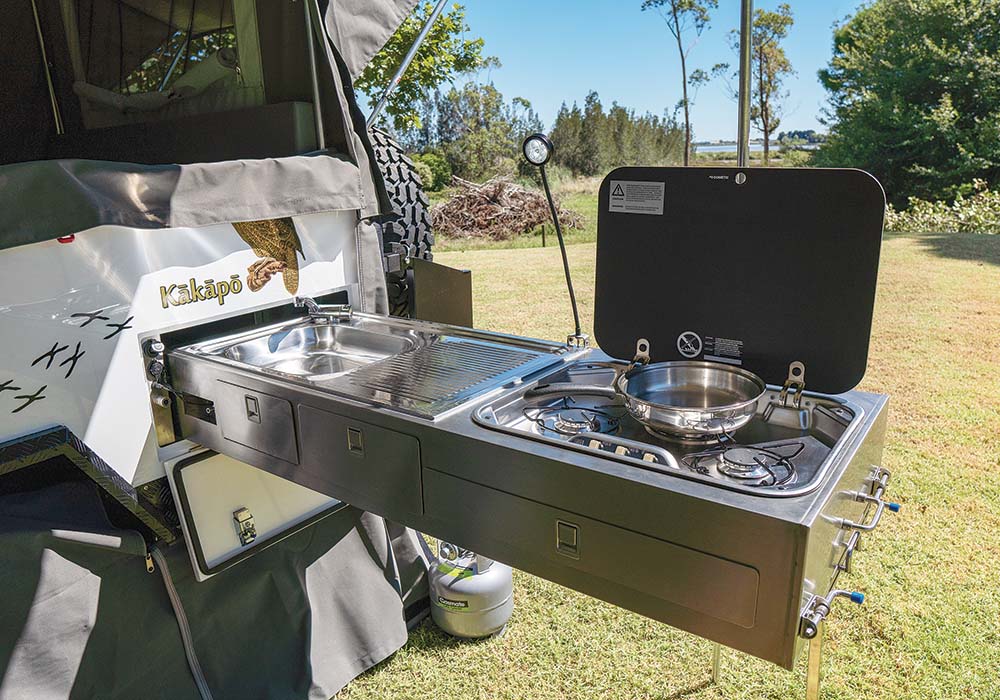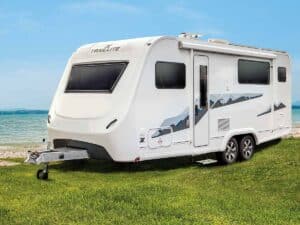Roomy and robust, Paul Owen discovers that the Bivouac Kākāpō trailer camper is ready for anything.
Back in the days when the Boy Scouts trained us to become adolescent versions of Bear Grylls, I had to pass an overnight survival test at the tender age of 14. This involved building something called a bivouac to spend the night in; mine was an A-frame of manuka sticks tied together with strips of flax and covered with ponga fronds. That crude shelter served its purpose, and I was eventually awarded my badge, but there’s no way that it could compare to the Bivouac you see on these pages, a relatively luxurious camping trailer that’s ready to go anywhere and become an easy-to-set-up base for adventure.
Camping trailers have long been part of the roadscape in Australia, but the concept of an easy-to-tow and store, affordable ‘imploding caravan’ is only beginning to catch on here in New Zealand. So, when Tauranga residents Fergus King and Chris Snelson were looking for a business that they could run in a semi-retired fashion, they decided to import Australian-designed, Chinese-made, camping trailers in knocked-down form, and assemble them here.
“We had intended to import an Australian brand of camping trailer,” says Fergus, “but then we discovered that a single Chinese company supplies all the components for a whole raft of Australian camping trailer companies. So, we went to them directly as it enabled us to establish our own brand and to tweak the design a little to better suit our New Zealand camping preferences.”
The launch of Bivouac campers on the New Zealand market four years ago essentially marked the end of semi-retirement for Fergus and Chris. “The one you see before you is number 132, and the more we build and sell, the more the phone rings with calls from people wanting one. One customer even chased one down the road but said the owner wouldn’t pull over to let him have a closer look.”

It takes Fergus and Chris two days to assemble a camper, and they admit to being “several units behind” with orders. Some of this is due to component shortages, especially for the extras required for the $4,500 premium package that can be added to the base $22,000 Kākāpō camper. This adds a 44-litre Waeco chest fridge, 240v battery charger, two-way towing hitch for off-road use, portable toilet, gas califont and shower with extra gas bottle, spare mag wheel fitted with a 265/75R16 Goodride all-terrain tyre, and a 120-watt portable solar panel. Customers can specify individual items from the package if they already own some of the components.
The pair always keep enough parts and components on hand to build 12 campers but have found that transportation has become less predictable as the pandemic has developed. “We’d order 40-foot containers of parts weeks apart, only to find that the third one that we ordered turned up well ahead of the first two,” says Chris.
Fergus says that supply has now stabilised somewhat, but adds that he and Chris have had to absorb some big increases in transport costs. That the base Kākāpō launched with a price of $19,800 four years ago, and now costs $22,000 in these far more ‘interesting times’ is testament to their commitment towards maintaining price stability and keeping their place as the leading camping trailer brand in New Zealand.
Bivouac buyers, says Fergus, are, in general, “people transitioning from tents, who are not yet ready for a caravan. They want to retain the indoor/outdoor flow they are used to, but seek more home comforts and easier camping set-up and packing up.”
It takes roughly 10 minutes in total to transition the Kākāpō from a compact trailer to a relatively spacious camper by flipping over the two checker plate roofs of the trailer to erect the canvas roof. This reveals both a double bedroom at the front of the camper and a U-shaped dining area at the rear. The 15-ounce heavy-duty canvas is quickly stretched into a roomy marquee-like shape by expanding struts, but if more shelter is required it can take a further 30 minutes to fully erect the large awning that comes with the camper, and adds an extra room (usually used as a bathroom/toilet). Making the whole process easier are the dedicated storage areas for the canvas zip-ons, poles, struts and pegs so that you know where everything is at setup and where it all eventually goes when packing up.
“Another major reason people buy a camping trailer is the ease of towing one,” says Fergus. “They’re light (an unladen Kākāpō weighs 1400kg), and you can see absolutely everything that’s behind and around you.” Then, when you return home again, a compacted camping trailer takes up less parking space on the property than a caravan.

IN THE ROUGH
Here’s where the robust Australian design comes to the fore, as the Kākāpō is designed to really tackle the rough stuff. Perhaps it should be named after a more inquisitive and active native parrot like the kea instead one noted for meandering slowly along the forest floor, seemingly stoned on fermented miro berries. For this is a camping trailer made to be towed far further into the depths of the New Zealand wilderness than any caravan.“It’ll go anywhere that the ute towing it can go,” says Chris.
Key to this all-terrain ability is the generous ground clearance that encourages potential customers to crouch down and take a look beneath the camper. The undercarriage of the Bivouac is certainly impressive enough to extract the odd unintended expletive from those who view it for the first time. There’s industrial-strength independent coil sprung suspension backed up by dual shock absorbers to control the movements of each wheel, and beefy safety chains to prevent the coil springs from popping out should the trailer become airborne when the tow vehicle flies over the crest of a sand dune. To the rear there’s the 120-litre stainless steel water tank, surrounded by thick alloy checker plate armour to prevent it being punctured by rocks and hard impacts. From the view down under, the Kākāpō, with its single-piece galvanised steel chassis, appears to be built to survive the Apocalypse.
Although similar Australian camping trailers offer more water storage in keeping with their mission to provide long-term outback accommodation, the Bivouac deletes the extra water tank so that New Zealand owners can take advantage of a larger payload. With the ability to carry 500kg to take the Gross Vehicle Mass limit to 1900kg, there’s plenty of load weight capacity left for bicycles (there’s a handy rack mounting point beneath the Kākāpō), spare wheels, and other touring essentials.
The choice of Goodride Radial H/T tyres with their all-surface knobbly treads should ensure the Bivouac remains stable when towed off-road. The strong back country credentials of the Kākāpō have made it a popular choice among four wheel drive club members, to the point where half of Bivouac buyers are from the South Island. “There’s so much more potential to explore and camp off-road down there,” says Fergus.

LET’S GO GLAMPING
Although it’s built like a former Mr. Universe and governor of California, there’s plenty of comfort to be found inside the Bivouac. Taller folk will appreciate that the tent roof is located 2.2 metres above the floor of the camper, while the main bed measures 1.95m x 1.6m. The U-shaped dining area has an adjustable table and seats six, and plates and drinks can be handed back and forth through the large open window to and from the slide-out stainless-steel kitchen outside. The latter has a three-burner gas hob, a sink, a cutlery drawer, and plenty of fold out workspace areas.


The dining area squabs can be arranged into a second double bed if required, and there are three 12-volt sockets and several LED lights mounted inside the camper. Access and egress to and from the trailer is via a handy fold down two-step ladder. With two 100Ah deep cycle batteries to keep the fridge and the lighting going, the Bivouac can stay parked up in one place off-grid for quite some time, especially with the optional portable solar panel keeping the batteries topped up.
As mentioned, a third room comes as standard with the Kākāpō, to be added outside in the awning area as an ensuite, especially as a pressurised shower outlet is located on that side of the camping trailer. The premium Kākāpō could qualify for full self-containment certification, with a few easy modifications like the addition of a sealed greywater catch tank.


THE FINER DETAILS
Other areas where the Bivouac differs from Australian lookalikes are the provision of two gas bottles (a 9kg backed up by a 4kg), and the provision of a stainless steel bin at the rear with drain holes in the floor so that items like wetsuits can dry out.
There are four stabiliser legs located in each corner of the trailer so that you can get it on the level, as the trailer has a slight tilt forward when hitched up to most vehicles. Assisting Bivouac owners to turn their compressed trailers into canvas palaces are the two hand winches located at either end of the trailer to help fold things out.
There are 12” electric brakes on each of the wheels, and the dual safety chains and the heavy-duty jockey wheel are items often reserved for far heavier trailers than this one. Along with the baked enamel finish of the exterior trailer panels and the copious use of stainless steel for the lockable slide-out storage boxes and drawers, it all adds to an impression of robustness in keeping with the Bivouac’s adventurous mission.


TO FOLD OR NOT TO FOLD?
A camping trailer won’t be everyone’s choice of mobile home, but there’s a lot to be said for their sheer affordability, their obvious advantages over tents, and their undisputed ease of towing. Just about anything with a 2000kg tow rating can tow a Bivouac once the requisite towbar is fitted, although it’s best to choose something with plenty of ground clearance. Subaru Outback wagons, and the plethora of 4wd separate-chassis utes on the market appear to be ideal candidates as tow vehicles for the Kākāpō.


Bivouac Kākāpō Specifications
|
Berths |
4 |
|
Chassis |
Galvanised steel with independent coil-sprung suspension |
|
Fresh/Grey Water |
Fresh 100L/Grey BYO container |
|
GVW |
1900kg (unladen mass: 1400kg) |
|
Price |
$23,000 ($27,500 with premium package) |
For more information, visit Bivouac Campers.






